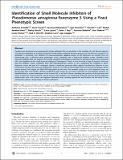| dc.contributor.author | Arnoldo, Anthony | |
| dc.contributor.author | Curak, Jasna | |
| dc.contributor.author | Kittanakom, Saranya | |
| dc.contributor.author | Chevelev, Igor | |
| dc.contributor.author | Sahebol-Amri, Mehdi | |
| dc.contributor.author | Koscik, Becky | |
| dc.contributor.author | Ljuma, Lana | |
| dc.contributor.author | Roy, Peter J. | |
| dc.contributor.author | Bedalov, Antonio | |
| dc.contributor.author | Giaever, Guri | |
| dc.contributor.author | Nislow, Corey | |
| dc.contributor.author | Merrill, Rod A. | |
| dc.contributor.author | Stagljar, Igor | |
| dc.contributor.author | Snyder, Michael | |
| dc.contributor.author | Lee, Vincent | |
| dc.contributor.author | Lory, Stephen | |
| dc.date.accessioned | 2011-10-31T16:38:35Z | |
| dc.date.issued | 2008 | |
| dc.identifier.citation | Arnoldo, Anthony, Jasna Curak, Saranya Kittanakom, Igor Chevelev, Vincent T. Lee, Mehdi Sahebol-Amri, Becky Koscik, and et al. 2008. Identification of small molecule inhibitors of Pseudomonas aeruginosa exoenzyme S using a yeast phenotypic screen. PLoS Genetics 4(2): e1000005. | en_US |
| dc.identifier.issn | 1553-7390 | en_US |
| dc.identifier.uri | http://nrs.harvard.edu/urn-3:HUL.InstRepos:5332808 | |
| dc.description.abstract | Pseudomonas aeruginosa is an opportunistic human pathogen that is a key factor in the mortality of cystic fibrosis patients, and infection represents an increased threat for human health worldwide. Because resistance of Pseudomonas aeruginosa to antibiotics is increasing, new inhibitors of pharmacologically validated targets of this bacterium are needed. Here we demonstrate that a cell-based yeast phenotypic assay, combined with a large-scale inhibitor screen, identified small molecule inhibitors that can suppress the toxicity caused by heterologous expression of selected Pseudomonas aeruginosa ORFs. We identified the first small molecule inhibitor of Exoenzyme S (ExoS), a toxin involved in Type III secretion. We show that this inhibitor, exosin, modulates ExoS ADP-ribosyltransferase activity in vitro, suggesting the inhibition is direct. Moreover, exosin and two of its analogues display a significant protective effect against Pseudomonas infection in vivo. Furthermore, because the assay was performed in yeast, we were able to demonstrate that several yeast homologues of the known human ExoS targets are likely ADP-ribosylated by the toxin. For example, using an in vitro enzymatic assay, we demonstrate that yeast Ras2p is directly modified by ExoS. Lastly, by surveying a collection of yeast deletion mutants, we identified Bmh1p, a yeast homologue of the human FAS, as an ExoS cofactor, revealing that portions of the bacterial toxin mode of action are conserved from yeast to human. Taken together, our integrated cell-based, chemical-genetic approach demonstrates that such screens can augment traditional drug screening approaches and facilitate the discovery of new compounds against a broad range of human pathogens. | en_US |
| dc.language.iso | en_US | en_US |
| dc.publisher | Public Library of Science | en_US |
| dc.relation.isversionof | doi://10.1371/journal.pgen.1000005 | en_US |
| dc.relation.hasversion | http://www.ncbi.nlm.nih.gov/pmc/articles/PMC2265467/pdf/ | en_US |
| dash.license | LAA | |
| dc.subject | biochemistry | en_US |
| dc.subject | drug discovery | en_US |
| dc.subject | infectious diseases | en_US |
| dc.subject | antimicrobials and drug resistance | en_US |
| dc.subject | bacterial infections | en_US |
| dc.subject | microbiology | en_US |
| dc.subject | applied microbiology | en_US |
| dc.title | Identification of Small Molecule Inhibitors of Pseudomonas aeruginosa Exoenzyme S Using a Yeast Phenotypic Screen | en_US |
| dc.type | Journal Article | en_US |
| dc.description.version | Version of Record | en_US |
| dc.relation.journal | PLoS Genetics | en_US |
| dash.depositing.author | Lory, Stephen | |
| dc.date.available | 2011-10-31T16:38:35Z | |
| dash.affiliation.other | HMS^Microbiology and Molecular Genetics | en_US |
| dc.identifier.doi | 10.1371/journal.pgen.1000005 | * |
| dash.authorsordered | false | |
| dash.contributor.affiliated | Lory, Stephen | |


